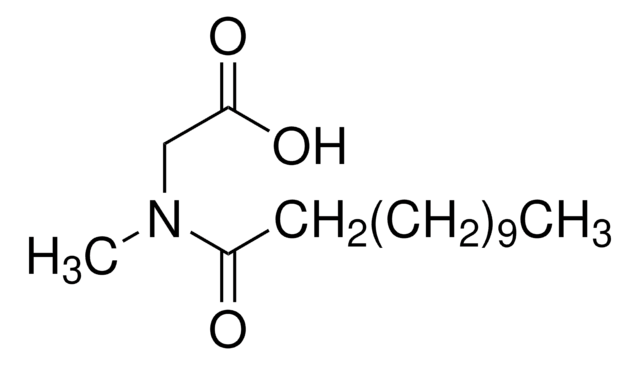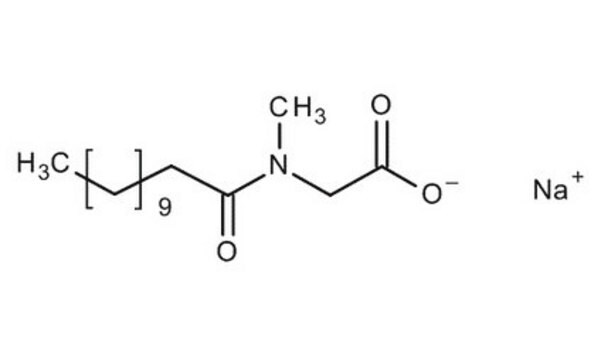61743
N-Lauroylsarcosine sodium salt
BioUltra, for molecular biology, ≥99.0% (HPLC)
Synonyme(s) :
N-lauroylsarcosine sodium salt, N-Dodecanoyl-N-methylglycine sodium salt, Sarkosyl NL
About This Item
Produits recommandés
Qualité
for molecular biology
Niveau de qualité
Description
anionic
Gamme de produits
BioUltra
Pureté
≥99.0% (HPLC)
Forme
powder
Poids mol.
micellar avg mol wt 600
average mol wt 600
Nombre d'agrégation
2
Impuretés
DNases, none detected
RNases, none detected
insoluble matter, passes filter test
phosphatases, none detected
proteases, none detected
Perte
≤1% loss on drying, 110 °C
pH
7.0-9.0 (25 °C, 1 M in H2O)
CMC
14.6 mM (20-25°C)
Solubilité
H2O: 1 M at 20 °C, clear, colorless
Traces d'anions
chloride (Cl-): ≤50 mg/kg
sulfate (SO42-): ≤50 mg/kg
Traces de cations
Al: ≤5 mg/kg
As: ≤0.1 mg/kg
Ba: ≤5 mg/kg
Bi: ≤5 mg/kg
Ca: ≤10 mg/kg
Cd: ≤5 mg/kg
Co: ≤5 mg/kg
Cr: ≤5 mg/kg
Cu: ≤5 mg/kg
Fe: ≤5 mg/kg
K: ≤50 mg/kg
Li: ≤5 mg/kg
Mg: ≤5 mg/kg
Mn: ≤5 mg/kg
Mo: ≤5 mg/kg
Ni: ≤5 mg/kg
Pb: ≤5 mg/kg
Sr: ≤5 mg/kg
Zn: ≤5 mg/kg
λ
1 M in H2O
Absorption UV
λ: 260 nm Amax: 0.2
λ: 280 nm Amax: 0.06
Chaîne SMILES
[Na+].CCCCCCCCCCCC(=O)N(C)CC([O-])=O
Application(s)
sample preservation
InChI
1S/C15H29NO3.Na/c1-3-4-5-6-7-8-9-10-11-12-14(17)16(2)13-15(18)19;/h3-13H2,1-2H3,(H,18,19);/q;+1/p-1
Clé InChI
KSAVQLQVUXSOCR-UHFFFAOYSA-M
Vous recherchez des produits similaires ? Visite Guide de comparaison des produits
Description générale
Application
- of nuclease stop mix, embryo extract buffer to dissociate nonspecifically bound proteins from chromatin
- of proteinase K solution for the heat denaturation of genomic DNA
- of 10% (w/v) sarcosyl/0.5 M ethylenediaminetetraacetic acid (EDTA) solution to prepare EDTA-sarcosyl-proteinase (ESP) buffer
- in the hybridization buffer for in situ hybridization histochemistry
- in the embryo extract buffer to dissociate nonspecifically bound proteins from chromatin
- in proteinase K solution to inactivate the enzymes
Autres remarques
Mention d'avertissement
Danger
Mentions de danger
Conseils de prudence
Classification des risques
Acute Tox. 2 Inhalation - Eye Dam. 1 - Skin Irrit. 2
Code de la classe de stockage
6.1A - Combustible acute toxic Cat. 1 and 2 / very toxic hazardous materials
Classe de danger pour l'eau (WGK)
WGK 1
Point d'éclair (°F)
512.6 °F - closed cup
Point d'éclair (°C)
267 °C - closed cup
Équipement de protection individuelle
Eyeshields, Gloves, type N95 (US)
Certificats d'analyse (COA)
Recherchez un Certificats d'analyse (COA) en saisissant le numéro de lot du produit. Les numéros de lot figurent sur l'étiquette du produit après les mots "Lot" ou "Batch".
Déjà en possession de ce produit ?
Retrouvez la documentation relative aux produits que vous avez récemment achetés dans la Bibliothèque de documents.
Les clients ont également consulté
Notre équipe de scientifiques dispose d'une expérience dans tous les secteurs de la recherche, notamment en sciences de la vie, science des matériaux, synthèse chimique, chromatographie, analyse et dans de nombreux autres domaines..
Contacter notre Service technique










